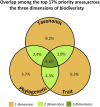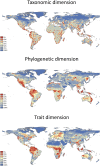Global priorities for conservation across multiple dimensions of mammalian diversity
- PMID: 28674013
- PMCID: PMC5530698
- DOI: 10.1073/pnas.1706461114
Global priorities for conservation across multiple dimensions of mammalian diversity
Abstract
Conservation priorities that are based on species distribution, endemism, and vulnerability may underrepresent biologically unique species as well as their functional roles and evolutionary histories. To ensure that priorities are biologically comprehensive, multiple dimensions of diversity must be considered. Further, understanding how the different dimensions relate to one another spatially is important for conservation prioritization, but the relationship remains poorly understood. Here, we use spatial conservation planning to (i) identify and compare priority regions for global mammal conservation across three key dimensions of biodiversity-taxonomic, phylogenetic, and traits-and (ii) determine the overlap of these regions with the locations of threatened species and existing protected areas. We show that priority areas for mammal conservation exhibit low overlap across the three dimensions, highlighting the need for an integrative approach for biodiversity conservation. Additionally, currently protected areas poorly represent the three dimensions of mammalian biodiversity. We identify areas of high conservation priority among and across the dimensions that should receive special attention for expanding the global protected area network. These high-priority areas, combined with areas of high priority for other taxonomic groups and with social, economic, and political considerations, provide a biological foundation for future conservation planning efforts.
Keywords: complementarity; phylogenetic dimension; spatial conservation prioritization; taxonomic dimension; trait dimension.
Conflict of interest statement
The authors declare no conflict of interest.
Figures








Similar articles
-
Global synergies and trade-offs between multiple dimensions of biodiversity and ecosystem services.Sci Rep. 2019 Apr 4;9(1):5636. doi: 10.1038/s41598-019-41342-7. Sci Rep. 2019. PMID: 30948774 Free PMC article.
-
Phylogenetically informed spatial planning as a tool to prioritise areas for threatened plant conservation within a Mediterranean biodiversity hotspot.Sci Total Environ. 2019 May 15;665:1046-1052. doi: 10.1016/j.scitotenv.2019.02.127. Epub 2019 Feb 11. Sci Total Environ. 2019. PMID: 30893736
-
Identifying global conservation priorities for terrestrial vertebrates based on multiple dimensions of biodiversity.Conserv Biol. 2024 Jun;38(3):e14205. doi: 10.1111/cobi.14205. Epub 2024 Feb 13. Conserv Biol. 2024. PMID: 37855155
-
Predicting loss of evolutionary history: Where are we?Biol Rev Camb Philos Soc. 2017 Feb;92(1):271-291. doi: 10.1111/brv.12228. Epub 2015 Oct 14. Biol Rev Camb Philos Soc. 2017. PMID: 26467982 Review.
-
Global biodiversity conservation priorities.Science. 2006 Jul 7;313(5783):58-61. doi: 10.1126/science.1127609. Science. 2006. PMID: 16825561 Review.
Cited by
-
Diel niche variation in mammals associated with expanded trait space.Nat Commun. 2021 Mar 19;12(1):1753. doi: 10.1038/s41467-021-22023-4. Nat Commun. 2021. PMID: 33741946 Free PMC article.
-
Community-level phylogenetic diversity does not differ between rare and common lineages across tallgrass prairies in the northern Great Plains.Ecol Evol. 2022 Nov 1;12(11):e9453. doi: 10.1002/ece3.9453. eCollection 2022 Nov. Ecol Evol. 2022. PMID: 36340814 Free PMC article.
-
Prioritizing phylogenetic diversity captures functional diversity unreliably.Nat Commun. 2018 Jul 23;9(1):2888. doi: 10.1038/s41467-018-05126-3. Nat Commun. 2018. PMID: 30038259 Free PMC article.
-
Conservation prioritization can resolve the flagship species conundrum.Nat Commun. 2020 Feb 24;11(1):994. doi: 10.1038/s41467-020-14554-z. Nat Commun. 2020. PMID: 32094329 Free PMC article.
-
Phylogenetically informed spatial planning is required to conserve the mammalian tree of life.Proc Biol Sci. 2017 Oct 25;284(1865):20170627. doi: 10.1098/rspb.2017.0627. Proc Biol Sci. 2017. PMID: 29070718 Free PMC article.
References
-
- Ellis EC, Ramankutty N. Putting people in the map: Anthropogenic biomes of the world. Front Ecol Environ. 2008;6:439–447.
-
- Barnosky AD, et al. Has the Earth’s sixth mass extinction already arrived? Nature. 2011;471:51–57. - PubMed
-
- Pimm SL, et al. The biodiversity of species and their rates of extinction, distribution, and protection. Science. 2014;344:1246752. - PubMed
-
- Vitousek PM, Mooney HA, Lubchenco J, Melillo JM. Human domination of Earth’s ecosystems. Science. 1997;277:494–499.
-
- Convention on Biological Diversity (2010) COP 10 Decision X/2: Strategic Plan for Biodiversity 2011–2020. Available at https://www.cbd.int/decision/cop/?id=12268. Accessed April 15, 2014.
Publication types
MeSH terms
LinkOut - more resources
Full Text Sources
Other Literature Sources

